Accepted Scientific Name: Chambeyronia macrocarpa Vieill.
Bull. Soc. Linn. Normandie sér. 2, vi. 230 (1873) nomen. (et Becc. in Palme Nuova Caledonia 1920).
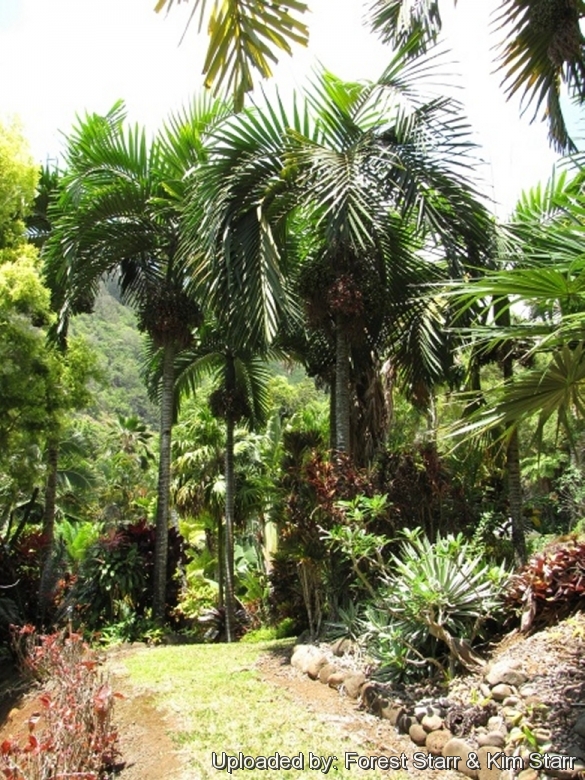
Kentia macrocarpa (Chambeyronia macrocarpa) Photo by: Forest Starr & Kim Starr
Habit at Iao Tropical Gardens of Maui, Maui, Hawaii (USA). May 22, 2012.
Origin and Habitat: New Caledonia Island (East of Australia).
Habitat: It grows in many soil types in the understory of moist rainforests or gallery forest nearly throughout New Caledonia from sea level to an elevation of 1000 metres.
Synonyms:
See all synonyms of Chambeyronia macrocarpa
back
Accepted name in llifle Database:Chambeyronia macrocarpa Vieill.Bull. Soc. Linn. Normandie sér. 2, vi. 230 (1873) nomen. (et Becc. in Palme Nuova Caledonia 1920).Synonymy: 9
back
Common Names include:
ENGLISH: New Caledonia red-leaved palm, Flame Thrower Palm, Red Feather Palm, Red Leaf Palm, Blushing Palm
FRENCH (Français): Palmier de Nouvelle Calédonie, Palmier de Houailou
GERMAN (Deutsch): Rotblattpalme
Description: Chambeyronia macrocarpaSN|24353]]SN|24353]] is a solitary palm up to about 20 m tall (but usually less than 15 m tall in cultivation), with a spectacular, feather-like bright red new leaf, which stays red for up to 10 days. The leaflets are also very wide, thick, and shiny so even without a new leaf it is very distinctive. It is also one of the most beautiful palms in cultivation.
Stems: Slender, smooth, clean, 12-25 cm in diameter, with rings at regular intervals along it, which are the scars left where leaves were attached that have now fallen.
Crown and shaft: This palm usually holds only 7 to 9 fronds so it does not cast dense shade. The crownshaft (leaf base between trunk and leaves) is dark green or yellow.
Leaves (fronds): Spirally arranged, pinnately compound, 2,1-4 m long. Each frond has 37-40 very distinctive leaflets , they wide, fat, leathery and flat and measure 7-10 cm wide and up to 90(-150) cm long. This species is best known for its bright red red or pink new fronds. Petiole up to 45 cm long.
Inflorescence: Up to 50 cm long at the base of the crownshaft.
Flowers: This palm species is monoecious, flowers are often arranged in groups of three containing two staminate and one pistillate flowers. The male flowers mature first and after the pollen has been shed the female flowers mature. Male flowers are cream-pink, contain 40-48 stamens, and are fragrant. Female flowers are white and contain an undivided ovary with a single ovule.
Fruit: More or less spherical in about 4,6 cm long.
Remarks: There are several varieties of this palm which have different crown shaft.
Bibliography: Moore, H.E. and N.W. Uhl. 1984. The indigenous palms of New Caledonia. Allertonia 3(5): 313-402.
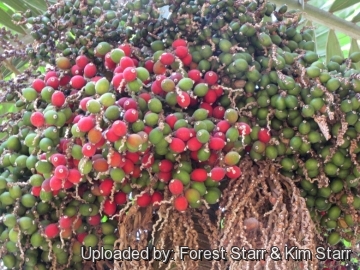 Fruit at Iao Tropical Gardens of Maui, Maui, Hawaii (USA). May 22, 2012. (Chambeyronia macrocarpa) Photo by: Forest Starr & Kim Starr
Fruit at Iao Tropical Gardens of Maui, Maui, Hawaii (USA). May 22, 2012. (Chambeyronia macrocarpa) Photo by: Forest Starr & Kim Starr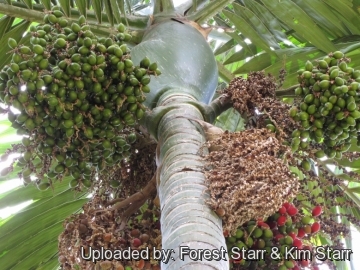 Fruit and crown at Iao Tropical Gardens of Maui, Maui, Hawaii (USA). May 22, 2012. (Chambeyronia macrocarpa) Photo by: Forest Starr & Kim Starr
Fruit and crown at Iao Tropical Gardens of Maui, Maui, Hawaii (USA). May 22, 2012. (Chambeyronia macrocarpa) Photo by: Forest Starr & Kim Starr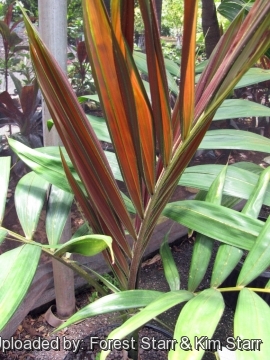 Reddish frond at Iao Tropical Gardens of Maui, Maui, Hawaii (USA). May 22, 2012 (Chambeyronia macrocarpa) Photo by: Forest Starr & Kim Starr
Reddish frond at Iao Tropical Gardens of Maui, Maui, Hawaii (USA). May 22, 2012 (Chambeyronia macrocarpa) Photo by: Forest Starr & Kim Starr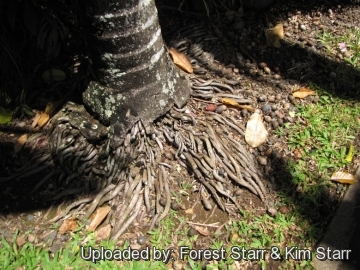 Base at Iao Tropical Gardens of Maui, Maui, Hawaii (USA). May 22, 2012. (Chambeyronia macrocarpa) Photo by: Forest Starr & Kim Starr
Base at Iao Tropical Gardens of Maui, Maui, Hawaii (USA). May 22, 2012. (Chambeyronia macrocarpa) Photo by: Forest Starr & Kim Starr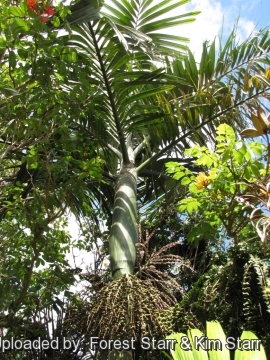 Watermelon form crown and fruit at Enchanting Floral Gardens of Kula, Maui, Hawaii (USA). March 12, 2012. (Chambeyronia macrocarpa) Photo by: Forest Starr & Kim Starr
Watermelon form crown and fruit at Enchanting Floral Gardens of Kula, Maui, Hawaii (USA). March 12, 2012. (Chambeyronia macrocarpa) Photo by: Forest Starr & Kim Starr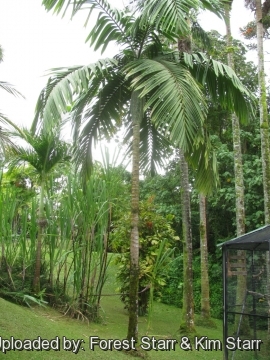 Habit at Panaewa Zoo, Hawaii. July 16, 2012. (Chambeyronia macrocarpa) Photo by: Forest Starr & Kim Starr
Habit at Panaewa Zoo, Hawaii. July 16, 2012. (Chambeyronia macrocarpa) Photo by: Forest Starr & Kim Starr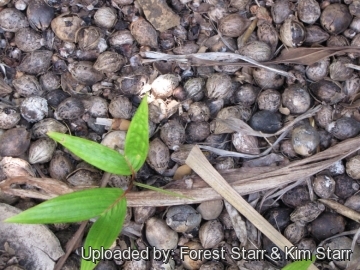 Fruit on ground with seedling at Iao Tropical Gardens of Maui, Maui, Hawaii (USA). May 22, 2012. (Chambeyronia macrocarpa) Photo by: Forest Starr & Kim Starr
Fruit on ground with seedling at Iao Tropical Gardens of Maui, Maui, Hawaii (USA). May 22, 2012. (Chambeyronia macrocarpa) Photo by: Forest Starr & Kim StarrSend a photo of this plant.The gallery now contains thousands of pictures, however it is possible to do even more. We are, of course, seeking photos of species not yet shown in the gallery but not only that, we are also looking for better pictures than those already present.
Read More... Cultivation and Propagation: It is a slow grower palm that likes rich sandy soil, but is adaptable to clay and loam both slightly alkaline and acidic. Good drainage is also important. The root system of this species is very sensitive and good sized specimen is extremely difficult to successfully dig and transplant to another location.
Fertilization: Need a perfect fertilizer diet including all micro nutrients and trace elements or slow release fertilizer. Micronutrient deficiencies are occasional problems. Micronutrient deficiencies only show up on soil with a high pH.
Watering: It enjoy rainy climates but tolerate a variety of conditions. In areas where summer rain is prevalent, it seems to put on rapid growth with this ample water, but it does not want to sit in continually wet, mucky soil. The roots and lower trunk can rot if soil is kept too moist.
Light: Prefers full sun but will tolerate half day sun.
Hardiness: It is one of the hardiest tropical feather palms, tolerating temperatures down to about -2 °C and has significant leaf damage below that. High temperatures will also stress it out, and it cannot grow in dry hot climates. (USDA hardiness zones: 9-11). This palm is recommended for subtropical and tropical climates.
Wind resistance: Strong winds will shred the leaflets, so plant in a protected area.
Aerosol salt tolerance: No salt tolerance.
Maintenance: Prune diseased, damaged or drying fronds, but do not prune if the frond still has some green colour. Palms recycle nutrients from dead or dying fronds and use them for healthier fronds. Palms only have a set number of new leaves that can sprout and grow per year and removing fronds will not increase that number. If you cut off more than what will grow annually, you could be left with a pretty bare and bald Palm.
Roots: Not a problem.
Uses: Either as a single specimen or in groups, this is a strikingly beautiful species (one of the most beautiful palms in the world). Its very neat appearance and stature makes it perfect to accent residential landscapes. Culture in containers is possible although growth rates are slower. A bright patio will provide an excellent environment for young specimens which can eventually be planted in a sunny location.
Pests & Diseases: Quite resistant to pests/diseases.
Propagation: Seeds.
















